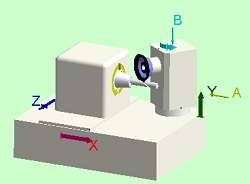KernelCAD
|
Simulation of grinding programming sample | |
| Developer(s) | DInsight |
|---|---|
| Stable release |
3.2
/ June 29, 2012 |
| Written in | C++ |
| Operating system | Windows |
| Type | CAD software |
| License | Free binary |
| Website | dynoinsight.com |
KernelCAD is a software development framework and set of components for enabling 3D/CAD functionality in Windows applications. KernelCAD was first developed by DInsight in 2001.
DInsight promotes KernelCAD as quick way to add 3D/CAD functionality without significant knowledge about the subject. It targets software engineers.
Architecture
Although it can be used directly as a set of Windows DLLs its main interface is implemented as Microsoft ActiveX controls. As such it can be added to forms or dialogs using development environments such as Microsoft Visual Studio (native and .NET languages are supported) or Borland Delphi. Some functionality can be used in background without creating a window. KernelCAD Viewer control is optimised for adding 3D solid render-only views to Microsoft Office documents and HTML, including compiled help.
The Modeling Studio application, included in the main product, acts mostly as a utility for operations like import/export, modeling of 3DS type of objects using arc and line splines and 3D debugger service.
Basic operations (Boolean Subtract, Cut Surface, measurements, etc.) are available in context menus of the component, but mostly functionality is expected to be programmed using an interface hierarchy.
As of version 4.1, the core of KernelCAD is released as free software. Some parts of the source code are open. AutoCAD data exchange and Euclidean shortest path modules are licensed.
Versions released in 2012 bifurcated into Standard Edition (v4.0) based on Open CASCADE Technology and KernelCAD Light (v3.2), which does not include bspline modelling and Step support.
Supported Formats
See also
External links
- "DInsight. Embedded CAD". Dynoinsight.com. Retrieved 2012-11-28.
- "Open CASCADE Technology, 3D modeling & numerical simulation". Opencascade.org. Retrieved 2012-11-28.
